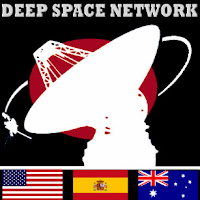Deep Space Network (DSN) logo.
August 24, 2019
Animation above: This animation illustrates Mars solar conjunction, a period when Mars is on the opposite side of the Sun from Earth. During this time, the Sun can interrupt radio transmissions to spacecraft on and around the Red Planet. Image Credits: NASA/JPL-Caltech.
The daily chatter between antennas here on Earth and those on NASA spacecraft at Mars is about to get much quieter for a few weeks.
That's because Mars and Earth will be on opposite sides of the Sun, a period known as Mars solar conjunction. The Sun expels hot, ionized gas from its corona, which extends far into space. During solar conjunction, this gas can interfere with radio signals when engineers try to communicate with spacecraft at Mars, corrupting commands and resulting in unexpected behavior from our deep space explorers.
Mars in a Minute: What Happens When the Sun Blocks our Signal?
To be safe, engineers hold off on sending commands when Mars disappears far enough behind the Sun's corona that there's increased risk of radio interference.
"It's that time again," said Roy Gladden, manager of the Mars Relay Network at NASA's Jet Propulsion Laboratory in Pasadena, California. "Our engineers have been preparing our spacecraft for conjunction for months. They'll still be collecting science data at Mars, and some will attempt to send that data home. But we won't be commanding the spacecraft out of concern that they could act on a corrupted command."
When is this taking place?
Solar conjunction occurs every two years. This time, the hold on issuing commands - called a "command moratorium" - will run from Aug. 28 to Sept. 7, 2019. Some missions will have stopped commanding their spacecraft earlier in preparation for the moratorium.
What happens to the spacecraft?
Although some instruments aboard spacecraft - especially cameras that generate large amounts of data - will be inactive, all of NASA's Mars spacecraft will continue their science; they'll just have much simpler "to-do" lists than they normally would carry out.
Image above: Curiosity's Selfie at 'Aberlady' and 'Kilmarie': NASA's Curiosity Mars rover took this selfie on May 12, 2019 (the 2,405th Martian day, or sol, of the mission). To the lower-left of the rover are its two recent drill holes, at targets called "Aberlady" and "Kilmarie." Image Credits: NASA/JPL-Caltech/MSSS.
On the surface of Mars, the Curiosity rover will stop driving, while the InSight lander won't move its robotic arm. Above Mars, both the Odyssey orbiter and the Mars Reconnaissance Orbiter will continue collecting data from Curiosity and InSight for return to Earth. However, only Odyssey will attempt to relay that data to Earth before conjunction ends. Meantime, another orbiter, MAVEN, will continue to collect its own science data but won't support any relay operations during this time.
Image above: InSight Deploys its Instruments: This artist's concept depicts NASA's InSight lander after it has deployed its instruments on the Martian surface. Image Credits: NASA/JPL-Caltech.
All of this means that there will be a temporary pause in the stream of raw images available from Curiosity, InSight and the other Mars missions. Mars solar conjunction impacts operations of all spacecraft currently at Mars, not just NASA's.
What happens when solar conjunction ends?
Once conjunction is over, the spacecraft will beam the data they've collected to NASA's Deep Space Network, a system of massive Earth-based radio antennas managed by JPL. Engineers will spend about a week downloading the information before normal spacecraft operations resume.
Image above: Deep Space Network antennas at Goldstone's "Apollo Valley". Image Credit: NASA.
If the teams monitoring these missions determine any of the collected science data are corrupted, they can usually have that data retransmitted after the moratorium ends on Sept. 7.
Related links:
Mars solar conjunction: https://mars.nasa.gov/all-about-mars/night-sky/solar-conjunction/
Curiosity (MSL): https://mars.nasa.gov/msl/multimedia/raw/#/?slide=2504
InSight: https://mars.nasa.gov/insight/multimedia/raw-images/?order=sol+desc%2Cdate_taken+desc&per_page=50&page=0&mission=insight
Deep Space Network (DSN): https://deepspace.jpl.nasa.gov/
For more about NASA's Mars Exploration Program, visit:
https://mars.jpl.nasa.gov
https://www.nasa.gov/mars
Images (mentioned), Animation (mentioned), Video, Text, Credits: NASA/Alana Johnson/JPL/Andrew Good.
Greetings, Orbiter.ch





